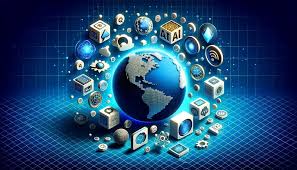Technology is evolving at an unprecedented rate, shaping the way we live, work, and interact with the world around us. “The Future of Innovation: Exploring Cutting-Edge Technology” takes a closer look at some of the most exciting advancements that are poised to transform industries and society in the years to come. From artificial intelligence to quantum computing, the future of innovation holds endless possibilities that can redefine human potential and problem-solving capabilities.
The Rise of Artificial Intelligence (AI)
Artificial Intelligence (AI) is arguably one of the most transformative technologies of the 21st century. AI systems can analyze vast amounts of data, learn from patterns, and make decisions with minimal human intervention. The applications of AI are vast, from improving healthcare diagnosis, optimizing business operations, to revolutionizing customer service with chatbots and virtual assistants.
In the future, AI is expected to become even more integrated into our daily lives, enabling smarter cities, personalized medicine, and autonomous transportation systems. As AI continues to evolve, it has the potential to increase efficiency, reduce human error, and solve complex global challenges, such as climate change, disease outbreaks, and energy consumption.
Quantum Computing: The Next Frontier
Quantum computing is one of the most exciting areas in technology today. Unlike traditional computers, which use bits to process information, quantum computers use quantum bits (qubits), which can exist in multiple states simultaneously. This ability to perform complex calculations at incredible speeds promises to unlock solutions to problems that are currently unsolvable.
In industries like pharmaceuticals, finance, and cybersecurity, quantum computing could drastically improve processing power, leading to breakthroughs in drug discovery, financial modeling, and data encryption. While still in its infancy, the potential of quantum computing to revolutionize technology and problem-solving is immense, offering capabilities that were once considered science fiction.
The Internet of Things (IoT): Connecting the World
The Internet of Things (IoT) refers to the interconnected network of devices that communicate and share data with each other. Everyday objects, from home appliances to cars and industrial machinery, are becoming “smart” through IoT technology, collecting and exchanging data to improve functionality and user experience.
In the near future, IoT will play a key role in creating smart cities, where traffic, energy use, and public services are optimized through real-time data. Additionally, IoT devices in healthcare, agriculture, and manufacturing will lead to more efficient operations, better resource management, and improved quality of life.
Blockchain Technology: Decentralizing the Future
Blockchain technology, best known for being the backbone of cryptocurrencies like Bitcoin, has far-reaching implications beyond digital currency. Blockchain is a distributed ledger system that allows for secure, transparent, and tamper-proof transactions. Its decentralized nature is poised to disrupt industries by eliminating the need for intermediaries, enhancing security, and increasing transparency.
Blockchain has the potential to revolutionize industries such as supply chain management, financial services, voting systems, and healthcare records. By creating an immutable record of transactions, blockchain can ensure greater accountability and streamline operations, making processes faster, more secure, and less prone to fraud.
Augmented Reality (AR) and Virtual Reality (VR): Redefining Experiences
Augmented Reality (AR) and Virtual Reality (VR) are technologies that have already started to reshape industries like entertainment, education, and healthcare. AR overlays digital information onto the real world, enhancing how we interact with our environment, while VR immerses users in entirely virtual environments.
In the future, AR and VR could revolutionize training programs, providing lifelike simulations for everything from medical procedures to military exercises. The gaming and entertainment industries will also continue to explore new possibilities, offering fully immersive experiences that engage the senses. Furthermore, these technologies are set to change how we work and collaborate, allowing for virtual meetings and team collaborations in more interactive and dynamic ways.
5G Technology: The Backbone of a Connected Future
5G is the fifth generation of mobile network technology, offering lightning-fast data speeds and incredibly low latency. It’s expected to be the backbone of future innovations, supporting everything from IoT devices to autonomous vehicles and smart infrastructure.
With 5G, the ability to connect large numbers of devices simultaneously will drive advancements in fields like telemedicine, smart cities, and remote work. It will enable real-time communication and data transfer on an unprecedented scale, helping industries become more efficient and responsive.
Biotechnology and Genetic Engineering: A New Era of Medicine
In the field of biotechnology, cutting-edge advancements are bringing us closer to revolutionizing healthcare. Gene editing tools like CRISPR allow scientists to modify DNA with unprecedented precision, offering the potential to cure genetic diseases, enhance agricultural productivity, and even extend human lifespan.
Furthermore, personalized medicine—where treatments are tailored to an individual’s genetic makeup—is expected to become more mainstream. These advances could lead to more effective therapies and even preventative treatments that target the root causes of diseases rather than just alleviating symptoms.
The Future of Technology: Challenges and Opportunities
While the future of technology is undoubtedly exciting, it also presents new challenges. Ethical concerns surrounding AI, data privacy, and the environmental impact of technological production are growing issues that need to be addressed. Additionally, the rapid pace of innovation may lead to job displacement in certain industries, requiring new approaches to education and workforce development.
However, with thoughtful planning and regulation, technology has the potential to improve the quality of life for millions of people worldwide. As new technologies emerge, they will open up new avenues for solving global challenges, increasing access to education and healthcare, and building a more sustainable future.
Conclusion: Embracing the Future of Innovation
The future of innovation is bright, and we are only scratching the surface of what’s possible. “The Future of Innovation: Exploring Cutting-Edge Technology” showcases how technologies like AI, quantum computing, IoT, blockchain, and more are reshaping industries and creating new opportunities. By embracing these advancements, we can unlock solutions to some of humanity’s most pressing challenges and build a better, more connected world for future generations.

